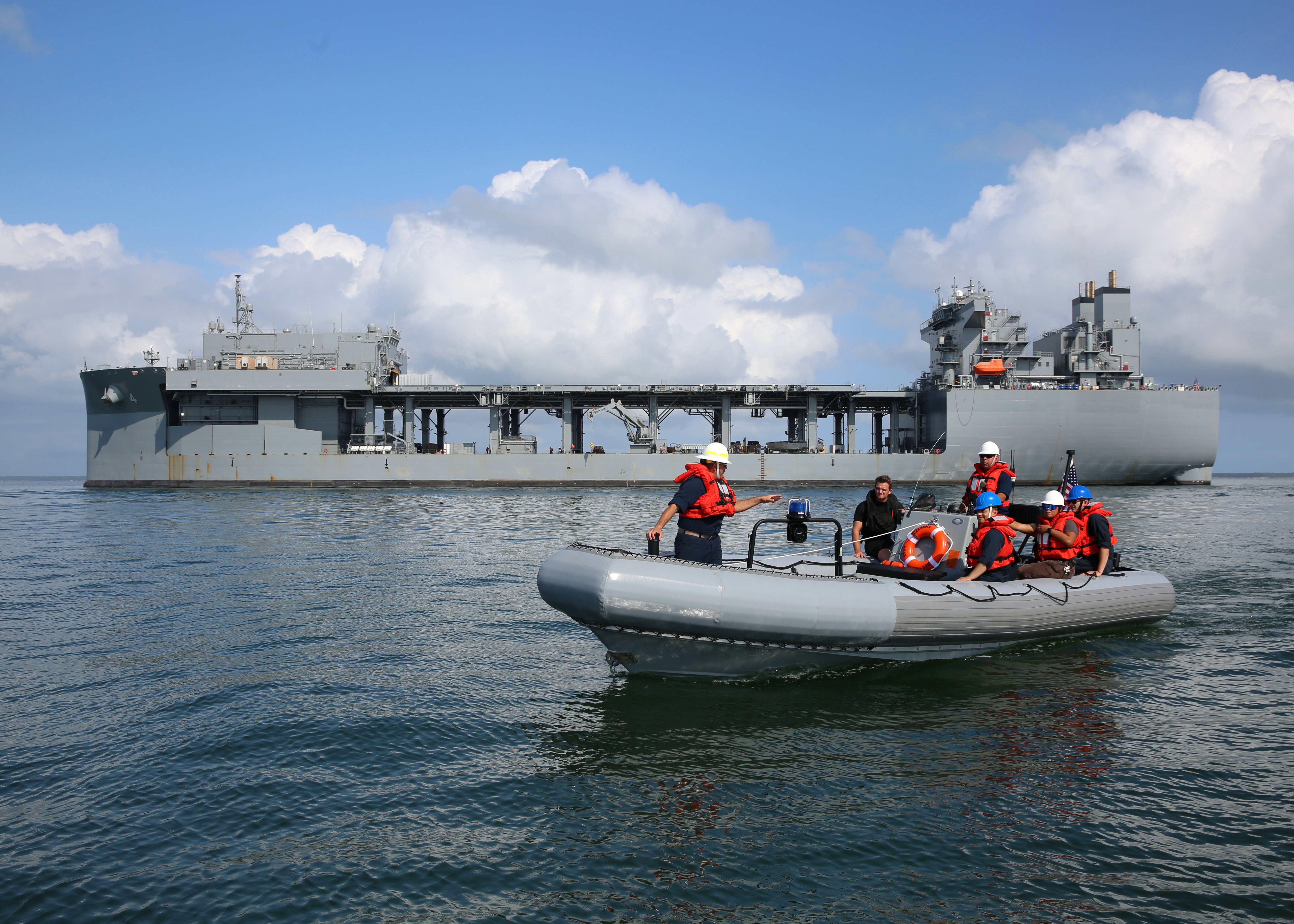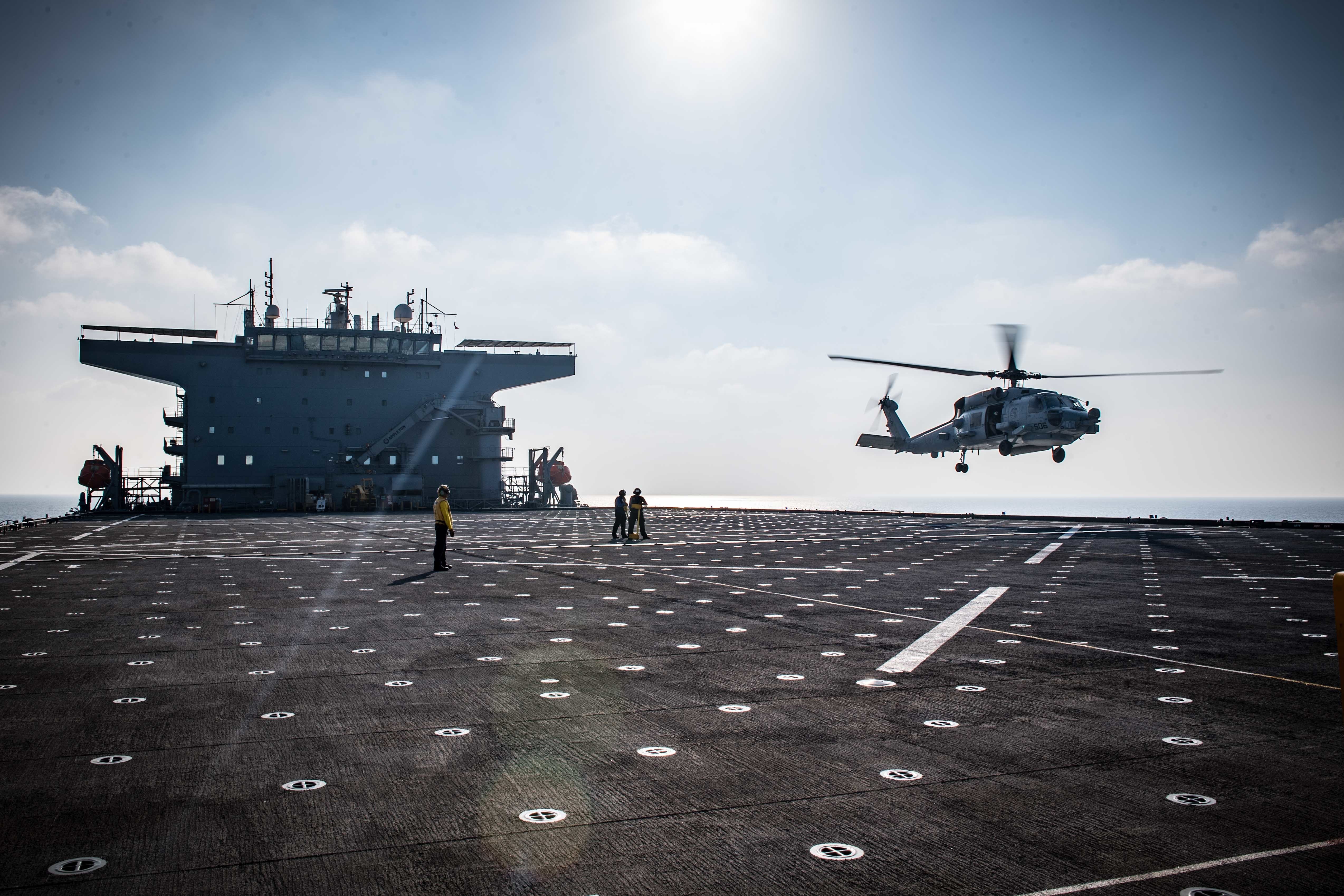
Expeditionary Sea Base USS Hershel “Woody” Williams (ESB-4) kicked off its first deployment today, leaving Virginia for an extended deployment primarily to U.S. Africa Command.
The Blue Crew departed Naval Station Norfolk today on the second-in-class ESB, which features a flight deck with four helicopter spots and a large reconfigurable mission deck for launching small craft, unmanned vehicles or other tools that embarked crews may bring with them. The 100 sailors and 44 civilian mariners will conduct missions that include counter-piracy and partner-training operations – two of the key missions the Navy typically conducts in the AFRCOM area of operations – and special operations forces support, one of the two missions the ESB platform was originally built for.
“The ship, and our presence, is a continuation of a long-standing commitment and will operate in close coordination to deepen operational relations with our partners, our allies, agencies and our other services,” Woody Williams Blue Crew Commanding Officer Capt. David Gray told reporters today at the pier before the ship left Norfolk.
“We are going to participate in military-to-military operations and exercises to increase our interoperability to help maintain those enduring partnerships and relationships. This will help maintain security and stability that is crucial in these important regions.”
Gray said the crew had trained for everything from lower-end tasks like a non-combatant evacuation operation all the way up to the high end of the warfighting spectrum. By bringing more capacity to an area of operations without much dedicated naval presence, though, the captain said Woody Williams would allow regional commanders to use the ESB to focus on lower-end missions, though, and free up any available destroyers or amphibious warships for high-end end missions.
“We’ve already got a great mission set set up, where we’re going, what we’re going to do and who we’re going to work with. And I tell you, it’s going to be very exciting,” he said, noting he’s been working with the staffs at U.S. 6th Fleet, AFRICOM, U.S. European Command and more for the last six months to get all the arrangements made for the deployment.
He said he’s been in close contact with the task forces (CTFs) at 6th Fleet: “61, 2, 3, 4, 5, all the way down, very excited about us coming. We bring multiple missions to the streets out there. We’ll provide another asset for them to be out there, to allow more flexibility for the amphibs that are out there and the other ships out at sea. We can do other missions that are in the lower end while they’re out doing the larger end, but when it comes to it we can all hit the high-end missions together.”
In addition to the flight deck and mission deck, the ship has berthing and work spaces for an embarked crew, along with all the command and control, communications and intelligence systems they could need to plan and execute missions.

In U.S. 5th Fleet, sister ship USS Lewis B. “Chesty” Puller (ESB-3) has been operating in theater since it first arrived in August 2017. Much like Woody Williams will, Puller swaps out its blue and gold crews periodically, leaving the ship in theater for constant presence and rotating the crews to keep them fresh. Puller has worked with special operations forces and Marines in the Middle East, as well as doing some mine countermeasures work – the other mission the ESBs were originally designed for.
Asked for more details on the missions Woody Williams would conduct, Gray confirmed there would be a heavy emphasis on counter-piracy and partner training. The ship is well suited for countering piracy and other illicit activities at sea, with the ability to support helicopters and unmanned aircraft at sea for extensive lengths of time, as well as launch a boarding team on small boats if needed.
“We do have a helo platform, we do have a mission deck for SPECWAR guys, so there’s a whole bunch of items that we’re tasked with coming up. And where’s it’s going to be, we’re still working some of those details, some of them are already set,” Gray said.
Much like Puller before it, Woody Williams began as a non-commissioned ship under Military Sealift Command but was commissioned on March 7, ahead of its deployment, to allow the ship to legally conduct certain warfighting missions while deployed overseas.
The ship will focus its time on AFRICOM but could conduct operations in the EUCOM or U.S. Central Command areas of operations as well, Gray said.

The Navy sends some ships into AFRICOM each year, especially for its Express series of training exercises: Phoenix Express in North Africa, Cutlass Express in East Africa, and Obangame Express in West Africa and the Gulf of Guinea.
A Spain-based destroyer, USS Carney (DDG-64), visited South Africa this year in a rare Cape Town port visit, during a patrol that included circumnavigating Africa – the first time a U.S. warship has done that in about a decade.
Still, there is much less Navy presence in AFRICOM than in other areas such as CENTCOM, U.S. Pacific Command and EUCOM. Asked what that meant for the crew and how it prepared for a deployment to a location with less Navy infrastructure and logistics and medical support, Gray said he was confident all the right arrangements had been made for a successful deployment.
“We’ve already worked all that out. … We worked with all the CTFs over there, especially 63 (logistics), 65 (surface combatants), and so forth on making sure all the logistics support is there. It’s relatively easy,” Gray said.
“We’ve also had one of the supply officers from Golf Crew, she just came from EUCOM, so she’s very familiar with all the operations, so we’ve all had tabletops and talkings, briefings, training, and to discuss what’s going on. We have a lot more infrastructure than you’d think that’s out there in the AFRICOM area. They’ve been operating down there for years. … I know the infrastructure’s there, it’s just you have to be very proactive to make sure you get ahead of the game because sometimes it takes a little bit of time to get logistics to where you need to be.”





